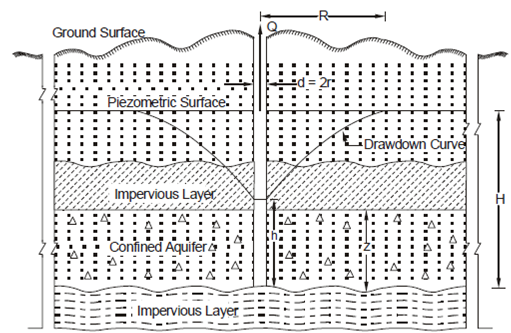Artesian Well:
In artesian well, water is drawn from a porous stratum underlying a relatively impervious one and so located that the contained water drawn from a distant elevated outcrop exerts more pressure upon the overlying cover. Due to this property, these are also known as pressure wells.
Whenever a water-bearing stratum dips below a relatively impervious one, the former becomes a closed conduit and if the flow out of this conduit at the lower end is impeded by any cause, the water accumulates and exerts more pressure against the impervious cover. The amount of this pressure depends on the extent to which the flow is obstructed and on the elevation of the upper end of the conduit. If a well is sunk through this impervious stratum at any point, the water rises in it. If surface topography and pressure are favourable, the water may rise to the surface in which case the well becomes a true artesian or flowing well.
The flow of ground water under equilibrium condition in artesian well is confined and is given by:
Q = 2.72 KZ (H - h)/Log (R)/ (r )
where, Q = Rate of flow in to well in m3/d,
K = Permeability constant in m/d,
Z = Thickness of the confined aquifer in meter,
H = Depth of water in the well before pumping in meter,
h = Depth of water in the well after pumping in meter,
R = Radius of influence in meter, and
r = Radius of well in meter.

Figure: Artesian Well under Equilibrium Condition
In general, the artesian wells have plentiful water and quality-wise it is relatively pure and normally does not need any treatment. However, it is very rare to get ideal artesian conditions.